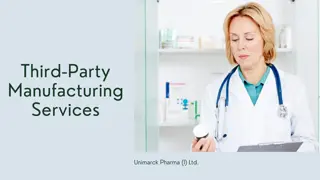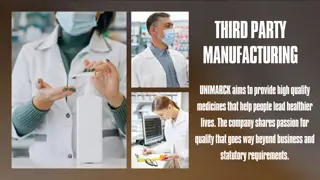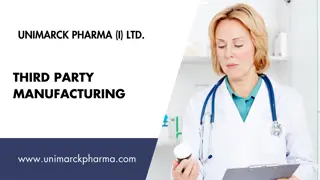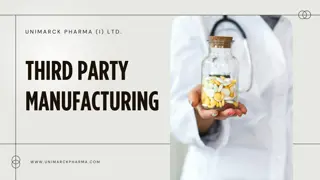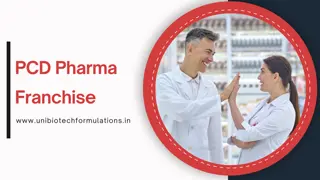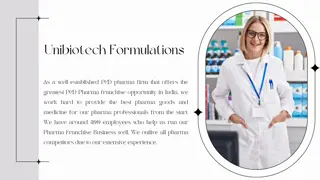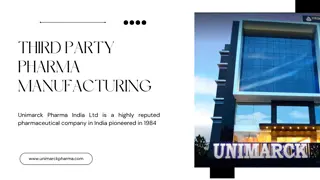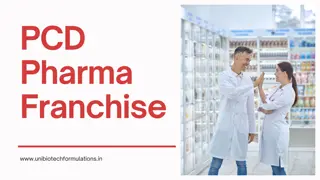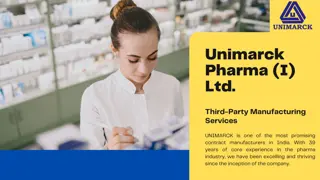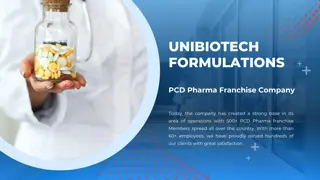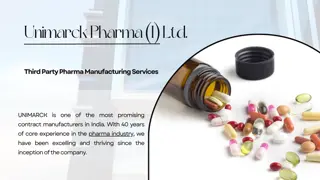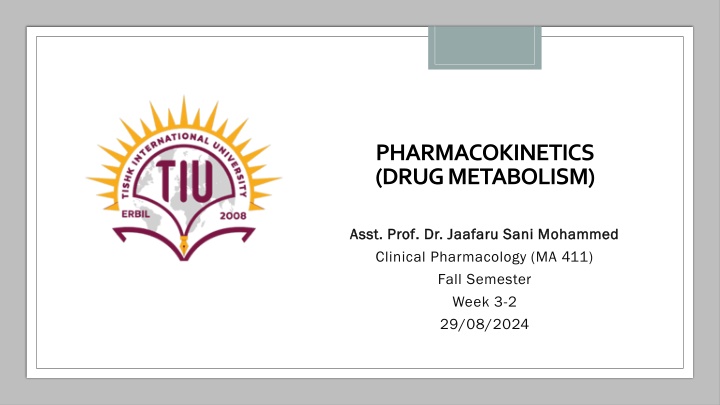
Drug Metabolism in Pharmacokinetics
Explore the important concepts of drug metabolism, including types of reactions, factors influencing metabolism, and the role of enzymes. Gain insights into how the body processes drugs to enhance their elimination and effects.
Download Presentation

Please find below an Image/Link to download the presentation.
The content on the website is provided AS IS for your information and personal use only. It may not be sold, licensed, or shared on other websites without obtaining consent from the author. If you encounter any issues during the download, it is possible that the publisher has removed the file from their server.
You are allowed to download the files provided on this website for personal or commercial use, subject to the condition that they are used lawfully. All files are the property of their respective owners.
The content on the website is provided AS IS for your information and personal use only. It may not be sold, licensed, or shared on other websites without obtaining consent from the author.
E N D
Presentation Transcript
PHARMACOKINETICS (DRUG METABOLISM) Asst. Prof. Dr. Jaafaru Sani Mohammed Asst. Prof. Dr. Jaafaru Sani Mohammed Clinical Pharmacology (MA 411) Fall Semester Week 3-2 29/08/2024
Outlines Objectives Introduction Types of metabolic reactions Site of drug metabolism Determinants of Drug Metabolism Factors affecting drug metabolism Summary
Objectives At the end of the lesson, the students should be able to understand: oThe metabolism. general concept and importance of drug oThe important pharmacological terminologies used in the lecture. oThe types of reactions (phase I and Phase II) involved in drug metabolism. oThe general factors that affect the metabolism of drugs inthe body. oThe mechanisms involved in biotransformation of drugs inthe body
Introduction oDrug metabolism, also known as the Biotransformation process, is an important mechanism by which the body terminates the action of many drugs or activates prodrugs. oMost drugsare relatively lipidsoluble as given, a characteristic needed for absorption across mem branes. oThe same propertywouldresult invery slow remov al fromthe body because the unchanged molecule wouldalso be readily reabsorbed from the urine in the renal tubule. oThe body hastens excretion by transformingmany drugsto lesslipidsoluble, less readily reabsorbed forms.
Cont. All organisms are exposed to foreign chemical compounds(xenobiotics) in the air, water, and food. To ensure elimination of drugs and to terminate the action of many endogenous substances, evolution has provided metabolic pathways that alter the activities of such compounds and their susceptibility to excretion.
Phase I reactions Reactions that convert the parent drug to a more polar (water-soluble) or more reactive product by unmasking or inserting a polar functional group such as OH, SH, or NH2. Phase II reactions Reactions that increase water solubility by conjugation of the drug molecule with a polar moiety such as glucuronate, acetate, or sulfate. CYP isozymes Cytochrome P450 enzyme species (eg, CYP2D6 and CYP3A4) are responsible for much of drug metabolism. Enzyme Induction Stimulation of drug-metabolizing capacity; usually manifested in the liver by increased synthesis of smooth endoplasmic reticulum (which contains high concentrations of phase I enzymes). P-glycoprotein, MDR-1 An ATP-dependent transport molecule found in many epithelial and cancer cells. The transporter expels drug molecules from the cytoplasm into the extracellular space. In epithelial cells, expulsion is via the external or luminal face.
Types of Metabolic reactions oPhase I Reaction oPhase I reactions include oxidation (by the cytochrome P450 enzymes), reduction, deamination, and hydrolysis. oPhaseIenzymes arefoundinhighconcentrationsinthe smoothendoplasmicreticulumofthe liver. oThey are not highly selective in their substrates, so a relatively small number of P450 isoforms are abletometabolize thousandsofdrugs. oMostofthe oxidationreactionsinphaseIareconducted byCYP450s family.
Cont. oB. Phase II Reactions oPhase II reactions are synthetic reactions that involve addition (conjugation) of subgroups to OH, NH2, and SH functions on the drug molecule. oThe subgroups that are added include glucuronate, acetate, glutathione, glycine, sulfate, and methyl groups. oMost of these groups are relatively polar and make the product less lipid-soluble than the original drug molecule. oLike phase I enzymes, phase II enzymes are not very selective. Drugs that are metabolized by both routes may undergo phase II metabolism before or after phase I.
Site of drug metabolism oThe most important organ for drug metabolism is the liver. oThe kidneys play an important role in the metabolism of some drugs. oA few drugs (eg, esters) are metabolized in many tissues (eg, liver, blood, intestinal wall) because of the wide distribution of their enzymes.
Determinants of Drug Metabolism o The rate of biotransformation of a drug may vary markedly among different individuals. o Some of this variation is due to genetic factors, a variety of drugs may induce or inhibit drug-metabolizing enzymes to a larger extent. o Smoking is a common cause of enzyme induction in the liver and lung and may increase the metabolism of some drugs. o For a few drugs, age or disease-related differences in drug metabolism are significant. In humans, gender is important for only a few drugs. (First-pass metabolism of ethanol is greater in men than in women.)
Major Factors affecting Drug Metabolism oA.Genetic Factors Several drug-metabolizing systems have long been known to differ among families orpopulations ingenetically determined ways. Because recent advances in genomic techniques are making it possible to screen fora hugevariety ofpolymorphisms. It is expected that pharmacogenomics will become an important part of patient evaluation in the nearfuture. The development wouldinfluence bothdrugchoiceanddrugdosage
Cont. oB. Effects ofOther Drugs Coadministration of certain agents may alter the disposition of many drugs (Drug-Drug interaction). Thiscouldbe done throughthe followingmechanisms: Enzymeinduction: Induction (increased rate of drug metabolism) results from increased synthesis of CYP450 enzymes inthe liveraswell asthe cofactor,heme. Several cytoplasmic drug receptors have been identified that result in activation of the genes for P450isoforms.
Cont. oDrugs and other xenobiotics that increase enzyme activity are known as inducers. oSeveral days are usually required to reach maximum induction; a similar amount of time is required to regress after withdrawal of the inducer. oThe most common strong inducers of drug metabolism are carbamazepine, phenobarbital, phenytoin, and rifampin.
Cont. o 2. Enzyme inhibition The inhibitors of drug metabolism involved in serious drug interactions are furanocoumarins (ingrapefruitjuice), azole(antifungals),andritonavir(HIV proteaseinhibitor). Suicide inhibitors are drugs that are metabolized to products that irreversibly inhibit the metabolizingenzyme, theyinclude ethinylestradiol,norethindrone,spironolactone,etc. Metabolism may also be decreased by pharmacodynamic factors such as a reduction in blood flowtothe metabolizingorgan.
Cont. o3. Inhibitors of intestinalP-glycoprotein P-glycoprotein(P-gp),isanimportantmodulatorofintestinaldrug transport. Its functions are to expel drugs from the intestinal mucosa into the lumen, thus contributing to pre- systemic (firstpass)elimination. They are found in the BBB and in drug-resistant cancer cells. Their inhibitors include mibefradil (a calciumchannelblocker), &furanocoumarin. TheImportantdrugs thatarenormallyexpelledby P-gpincludedigoxin,cyclosporineandsaquinavir.
Drug metabolism vs drug elimination Termination of drug action requires either removal of the drug from the body (excretion) or modification of the drug molecule (metabolism) so that it no longer has an effect. Both methods constitute drug elimination, and both are very important in the clinical use of drugs. Almost all drugs (or their metabolites) are eventually excreted, but for many, excretion occurs only after they have been metabolized to inactive products. A large number of drugs alter their own metabolism and the metabolism of other drugs either by inducing the synthesis of larger amounts of the metabolizing enzymes (usually P450 enzymes in the liver) or by inhibiting those enzymes. Some drugs both inhibit (acutely) and induce (with chronic administration) drug metabolism. Induction and inhibition of drug metabolism Toxic metabolism Some substances are metabolized to toxic molecules by drug-metabolizing enzymes. Important examples include methyl alcohol, ethylene glycol, and, at high doses or in the presence of liver disease, acetaminophen.
References Huang, S. M., Lertora, J. J., & Atkinson Jr, A. J. (Eds.). (2012). Principles of clinical pharmacology. Academic Press. Becker, D. E. (2013). Basic and clinical pharmacology of glucocorticosteroids.Anesthesia progress, 60(1), 25-32. BERTRAM G KATZUNG, K. A. T. Z. U. N. G. (2021). Basic & clinical pharmacology. EGC. Hedaya, M. A. (2012).Basic pharmacokinetics. CRC Press. Atkinson Jr, A. J. (2022). Introduction to clinical pharmacology. In Atkinson's Principles of Clinical Pharmacology(pp. 1-10). Academic Press.

